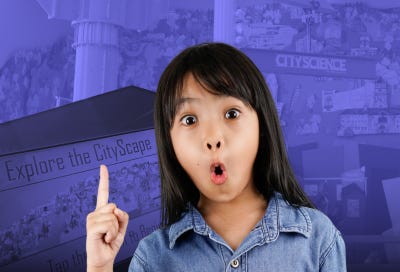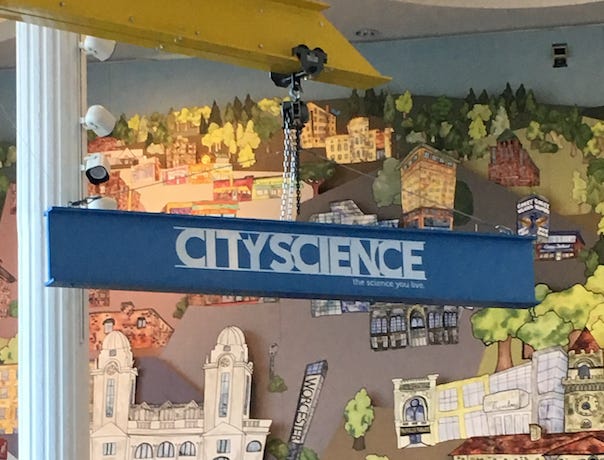In 2010, when I was the Manager of Exhibits at a midsized science and children's museum, our team started planning an exhibit, City Science, about the science of cities and urban ecosystems, using our city, Worcester, Massachusetts, as the case study. With urban environments as our focus, it seems inevitable that we’d cross paths with the planning profession, but it took us (or at least me) a while to recognize that. But we did start noticing … something.
People Love Thinking About Their City or Town
During our front-end evaluation, we assembled focus groups. We ran a quick (we thought) warm-up activity, asking people to use their senses and emotions to think about the city: “What does Worcester sound like?” “What do you love about Worcester?” We struck a nerve – in the best way. Lively - but civil - civics conversations would spring up around the room. It was hard to move people to the next brainstorming activity. This was a museum person’s dream – people were interested in, even invested in, the exhibit topic!
And people’s answers revealed interesting convergences and divergences: everyone agreed that Worcester smells like a legendary local hot dog joint and everyone hated the same intersections, but what does Worcester sound like? – that depended on the neighborhood where you lived. These answers guided much of the exhibit, including the inclusion of two interactives exploring people’s experience with the urban soundscape.
That was hint #1 that we were stumbling upon urban planning. At the end of our brainstorming meetings, people eagerly asked “Are you going to tell the ‘City’ [what we just said]?” Well, no – we were just trying to plan an exhibit – but in retrospect, what a missed opportunity!
Urban Planning is a Goldmine of Potential Museum Content
Once we had a list of potential exhibit themes and interactives, we needed subject matter experts, and we needed funding. We found both when my colleague Alice Promisel found the Boston Metropolitan Area Urban Long-term Ecological Research Area (BMA-ULTRA-EX) project (also here). The BMA-ULTRA-EX research delved into urban biodiversity, climate change, city design, urban greening, and land use – well more than half of our exhibit themes. One of UTLTRA-Ex’s co-Principal Investigators, Robert L. Ryan of University of Massachusetts Amherst’s Landscape Architecture and Regional Planning Department, worked with us to secure National Science Foundation funds (AISL1323168) to embed urban planning research into several City Science interactives.
Planning holds rich content for non-science museums as well. History museums will find no end of stories about stolen lands and erased BIPOC neighborhoods that need to be brought to light. See, for instance, the Walking Cinema stories created with the Smithsonian’s Anacostia Museum and the California Migration Museum, among others.
Art museums have a natural role in creative placemaking and promoting art that speaks to issues like climate and redlining.

Urban Planners Lean in When They Hear These Stories
My third “Aha” came after City Science opened, while watching a girl, about 8 years old, work with her grandmother to redesign a housing development she had just built at the interactive, “Turtle’s Eye View”. Seeing the impact of her development on a turtle’s habitat, she quickly replaced the large houses with smaller houses and gathered the remaining houses together, away from the riverfront. I realized she – and many visitors who followed – was instinctively creating cluster zoning, and that she was highly unlikely to be attending zoning board hearings.
I’ve told this story to many planners and to a person, they’ve been excited – about the level of engagement, about the ages of the participants, and about the parallels between our museum practice and their community engagement work. Carolina Prieto, former Assistant Director of Arts and Culture at the Boston-area Metropolitan Area Council said that interactives like “Turtle’s Eye View” intrigue planners because they “impart a lot of information [about planning topics] in a way that is accessible.”
Let’s Get Less Accidental
Ever since City Science opened my eyes, I’ve been noticing other museums working with planners doing inspiring, impactful stuff. But here’s the thing – like with City Science, those collaborations started almost accidentally - only after the museums’ projects crossed paths with planners’ work.
Serendipity like that is great, but it’s slow!
So, this is my call to museums and planners – start talking to each other, and investigate where you might collaborate.
~ Betsy Loring1
The Planning-Curious Museum Person
Sharing stories and ideas for other Planning-Curious Museum People and for Museum-Curious Planning People.
Don’t miss a post!
About the Planning-Curious Museum Person.
Betsy Loring is founder of expLoring exhibits & engagement. She has over 20 years’ experience in project management and exhibit development in multidisciplinary, indoor and outdoor museum settings. Her services include exhibit master planning, content and interactive development, and writing, with a focus on hands-on STEM. She also offers staff training in exhibition planning, formative evaluation, and prototyping. Special interests include multi-institutional collaborations, peer-to-peer professional development, and of course – collaboration with municipal planning practitioners.




